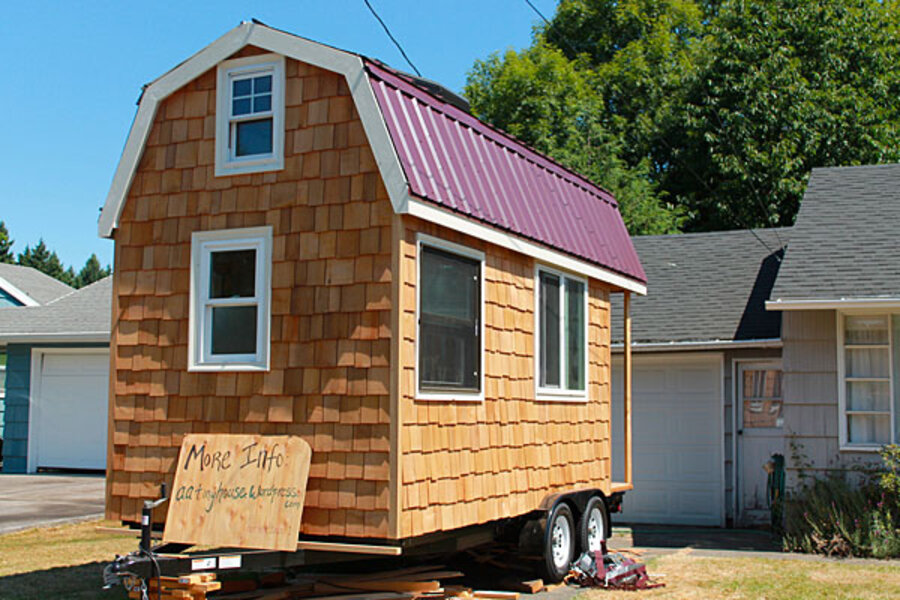Could you live in 150 square feet? Cities try out micro-housing.
Loading...
| Los Angeles
Despite a soft housing market nationwide, rents in some of America’s biggest cities are still beyond the means of many families and singles who both want and need to live downtown. So cities from San Francisco and Seattle to Chicago and New York have begun trials of ever-smaller efficiency apartments – dubbed micro-housing – in the hearts of their metropolises, proposing units as tiny as 150 square feet with monthly rents as low as $495.
On Tuesday afternoon, San Francisco’s Board of Supervisors met to discuss proposed legislation that would allow developers to build units at the 150-square-foot size.
While some applaud efforts to diversify these downtowns and give workers the opportunity to shorten their commutes to city centers, opponents question whether this move is good for the quality of life – either for the renters or for the nearby neighborhoods.
“Everyone agrees we have a housing crisis in San Francisco,” says Supervisor Scott Wiener, who represents District 8 and proposed the legislation under discussion. “A robust discussion about housing needs in the city benefits everyone.”
Many constituencies in San Francisco agree these units would be appropriate, Mr. Wiener adds. “We have a dramatic shortage of student housing, senior housing, and other needs such as emancipated foster youth,” he says, noting, “We are talking about doing it as a trial.”
Other cities have similar trials under way, such as New York City, where Mayor Michael Bloomberg recently approved a 60-unit development of micro-apartments at 275 square feet each.
But Jane Kim, another San Francisco supervisor, says there is little research about these kinds of units in her city and does not support rushing into new regulations that might open a door to developers. “Frankly, I don’t see the crushing need at that end of the spectrum,” she says, pointing to different demands in District 6, which she represents.
“The biggest need we see in San Francisco is in the two- and three-bedroom apartments for low-income families, not the small efficiency units,” Supervisor Kim says. Beyond that, she says, “we are not encouraging these kinds of developments because we have no idea how they will further strain our amenities – things such as schools, transportation, and especially open spaces.”
While US cities struggle with a lack of affordable housing in their downtowns, urban areas around the globe, from Paris to Tokyo, have been tackling this issue for a long time, points out New York designer and architect Alexander Gendell, whose company Folditure specializes in foldaway furniture for compact spaces.
Low quality of life does not have to go hand in hand with limited living space, he says. He points to Tokyo, where the Japanese have figured out how to make every inch of living space count, he says. “It’s entirely possible to live well in 200 square feet of living space,” he says, as long as every function has been well thought out.
“We are certainly not the first ones to deal with this issue,” Mr. Gendell says with a laugh. “We are blessed in this country with more living space,” he says, but many other nations have proved that it is entirely possible to live in a more concentrated living environment – one that would be better for the planet.
Chicago has had success with such micro-housing, says Charles Hoch, professor of urban planning at the University of Illinois at Chicago. Removing social fears is an important first step, he says, explaining that identifying small units exclusively with very low-income people tends to generate fears about concentrations of poor people attracting crime.
Downtown Chicago has benefited from thousands of dorm units built in large high-density buildings in recent decades, Professor Hoch says. Organizations like Mercy Housing Lakefront “have also built high-density buildings with small units for the homeless as well,” he says via e-mail, adding, “The more we increase the diversity and supply of small single-room units, the more rents will decline and more single people with moderate and low incomes will find a place to live.”
San Francisco must diversify to meet many needs, says Wiener, who is on the city’s land-use committee. “There is this perception that this legislation will open up a tidal wave of this construction,” he says, “but that’s just not true; it will be balanced.”





